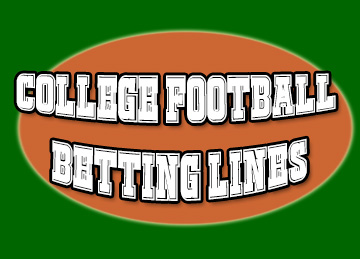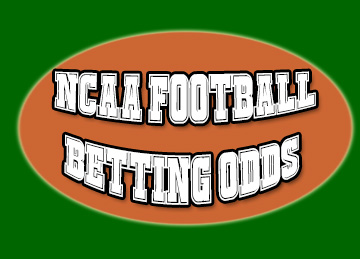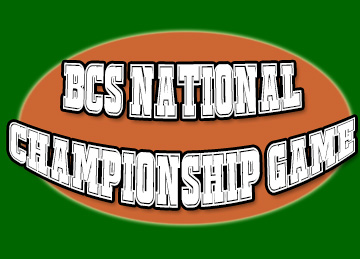NCAA COLLEGE FOOTBALL RULES

NCAA
COLLEGE FOOTBALL RULES
The Field is 100 yards long (and 160 feet wide). The middle of
the field is the 50 yard line. The lines are labeled every 10
yards descending in both directions from the 50 yard line. Thus
there are two 40 yard lines and no 60 yard line. Each team owns
half of the field (they switch sides every 15 minutes of play).
Thus, the two 40 yard lines are distinguished by who owns them.
The "zero yard line" is called the goal line. The areas to
either side of those 100 yards, extending 10 yards past the goal
lines, are called the end zones. Teams try to get the ball past
the opponent's goal line into the end zone to score a touchdown.
At far edge of each end zone are the goal posts which, together
with the cross bar, look like a big H. These are used only when
a team decides to kick a field goal instead of going for a
touchdown or to kick for an extra point after scoring a
touchdown. To score the field goal or extra point, the ball must
go between the vertical posts and over the bar.
In the other direction, the field is divided into three parts,
left, center and right, by the hash marks, which are 60 feet
from each side line. Normally, for each play, the ball starts
where it ended up at the end of the previous play. However, if
the ball ends up outside of the center part of the field, it is
brought back to the nearest hash marks so plays never start at
the extreme sides of the field. The area to either side of the
field is out-of-bounds.
Kickoffs:
At the start of the game there is a coin toss to see which team
gets the ball first. The team that has the ball is the offense;
the other team is the defense. A football game is supposedly one
hour, but takes about three hours to play because the clock is
often stopped for various reasons. The game is divided into 15
minute quarters with a major division at 30 minutes which is
called half time. At the end of the first and third quarters,
the players merely switch sides. The ball is moved to the
corresponding point on the other side of the field, and play
continues. This switching of sides evens up any advantage due to
the sun or wind. The players leave the field for 20 minutes at
half-time. After half-time, play does not continue where it
ended. Instead, the team that originally lost the coin toss gets
to have the ball first following another kickoff.
At the start of each half and after each touchdown or field goal
(when it's time to let the other team have the ball), the
defending team starts by placing the ball on a tee at their 35
yard line and kicking the ball toward the other team. This is a
kickoff. The other team tries to catch the ball and run it back
as far as possible. If the player catching the ball sees there
is no hope of running it back, he raises his hand asking for a
fair catch. In a fair catch, the defending team may not tackle
him and he may not run with the ball. If the ball is kicked into
the end zone and no one catches it or the player catching it
does not run with it, there is a touchback and the first play
starts at the offense's 20 yard line. Unlike a touchdown, a
touchback does not score any points.
Downs:
The offense has 4 plays or downs to cover 10 yards or more. A
play ends when the player with the ball is either stopped or
goes out-of-bounds or if the ball is thrown and missed (which is
called an incomplete pass). A player is stopped when his knees
touch the ground either because he was tackled by a defensive
player or because he fell. When a play is over an official blows
a whistle. Normally, teams try to cover the 10 yards in 3 plays
or less. If they don't make it in 3 plays, they use the 4th down
to kick the ball toward the other team. The ball is not placed
on the ground and kicked as it is in a kickoff. Instead, the
ball is snapped back to the kicker who kicks the ball. This is
punting. Teams don't have to punt on 4th down. Sometimes, if the
distance to complete the 10 yards is very short or if a team is
far behind in the score, they elect to go for it on 4th down--to
try to complete the 10 yards with another play. If they fail to
make it on 4th down, the ball is turned over on downs where it
ends up. On 4th down, if they are close enough to the defense's
goal posts, the offense may also elect to kick a field goal. If
the field goal misses, the ball is turned over to the other team
where it was before the field goal attempt.
If a team succeeds in advancing 10 yards or more, they get a
first down. That is, they get a new set of 4 downs to make
another 10 yards.
Scoring:
The object of the game is to score more points than your
opponent. A touchdown is worth 6 points. After a touchdown, the
team then attempts to kick the ball through the goal posts to
get an extra point. Because this kick almost always works, most
people think of a touchdown as being worth 7 points and then
subtract a point if the extra point kick is missed. The team
that scored the touchdown has the option of trying to get the
ball into the opponent's end zone again in just one running or
passing play instead of kicking for the extra point. If this two
point conversion works, they get two points instead of just one.
This is, however, more than twice as difficult as kicking an
extra point.
A field goal is worth is worth 3 points.
If an offensive player is stopped in his own end zone, the
defense scores a safety which is worth 2 points. This rarely
happens. After a safety, the offense must kick the ball to the
other team with a free kick where the kicker kicks the ball from
his own 20 yard line. It's called a free kick because the kicker
may not be tackled.
The Players:
Each team has 11 players on the field. Before a play starts, the
offensive players meet in a huddle to decide which play to use.
Plays are normally selected by the coaching staff who radio
their selection to the quarter back who then tells the other
players. The defensive players might also huddle to select their
own strategy for the next play. The players then come up to the
line of scrimmage which is an imaginary line drawn from one side
of the field to the other through the tip of the football
closest to the defense. Each team must stay on their own side of
the line of scrimmage until the play starts.
The offensive team typically has a quarter back (the team
leader), two additional players behind the quarterback often
called the fullback and the tailback, five players in a line in
front of the quarter back called the offensive line, and three
receivers off to either side of the offensive line that are
called tight end, split end, and flanker. The tight end is close
to the offensive line; the others are further away. The center
player of the five linemen on the offensive line is the center.
The defensive team typically has four linemen in front, three
line backers in back of them and four defensive backs further
back or to the sides called corner backs and safeties.
The Plays: The offensive linemen all put a hand
on the ground except for the center who puts both hands on the
ball. The quarter back stands behind the center with his hands
between the center's legs. The quarterback calls out a series of
signals. Only the offensive players know which signal starts the
play; the defense has to wait to see the play start before they
can react. Once the secret signal is given, the play starts when
the center snaps the ball to the quarterback. The offense has a
maximum of 25 seconds from the end of the previous play to start
the next play unless a time-out has been called.
In a pass play the quarterback takes a few steps back, waits for
someone to get open, and throws the ball to that person. That
pass receiver can be any offensive player other than a lineman.
During a pass play, the defensive front four rush the
quarterback hoping to either make him throw the ball early or
perhaps even sack him by tackling him before he throws the ball.
The offensive linemen try to prevent this by blocking the
defensive linemen. However, the offensive lineman are not
allowed to use their hands while blocking. Meantime the
defensive backs cover the receivers (try to stop the receivers
from catching the ball) by either running with them in
man-to-man coverage or by covering any receivers in their part
of the field in zone coverage. Sometimes the defensive team
blitzes by sending one or more defensive backs after the quarter
back. That can be dangerous because it can leave a receiver
open--but that won't matter if they can sack the quarterback.
If the pass is not caught before it touches the ground, it is an
incomplete pass and the ball returns to the original line of
scrimmage. If a pass is picked off (caught) by a defensive
player, it is an interception and the ball is turned over to the
other team.
In a rushing play the quarterback hands the ball off to the
tailback or, sometimes, the fullback and that person runs with
the ball. The offensive linemen try to open holes in the
defensive line for the rusher to run through by blocking the
defensive linemen. If the rusher fumbles by losing the ball
before the play is over, there is a mad scramble while everyone
tries to pounce on the ball. If a defensive player recovers the
fumble, the ball is turned over to the other team.
Penalties:
The people in the stripped shirts are the officials. They carry
out various tasks such as raising their arms to signal a
touchdown or field goal, deciding if a pass was caught in bounds
or out-of-bounds, placing the ball on the line of scrimmage for
the next play, measuring to see if 10 yards have been covered,
and assessing penalties for rule infractions. To call a penalty,
an official takes a piece of yellow cloth, called a penalty
marker or flag, from his pocket and throws it on the ground.
There is then a flag on the play.
Illegal procedure:
An offensive linemen moved before the play started or a receiver
who was in motion before the play started did not move parallel
with the line of scrimmage. Or the quarterback was past the line
of scrimmage when he threw a pass. 5 yard penalty.
Ineligible Receiver Down-field: An offensive
lineman was too far advanced past the line of scrimmage when the
quarterback threw a pass. 5 yard penalty.
Delay of Game:
The offensive team took more than 25 seconds to start the play.
5 yard penalty.
Grounding the Ball:
The quarter back threw the ball away instead toward a possible
receiver because he was about to be sacked. 5 yards and loss of
down.
Off-sides:
A defensive player moved across the line of scrimmage and either
made contact with an offensive player or failed to get back
before the play started. 5 yard penalty.
Holding:
An offensive lineman used his hands while blocking. 10 yard
penalty.
Clipping, Illegal Block, Chop Block:
Blocking a player from the back. This can hurt a player because
he doesn't know the hit is coming. 10 yards.
Pass Interference:
Grabbing or tackling the pass receiver while the pass is in the
air. The defender must wait until the ball arrives. However, the
defender can try the catch the ball himself, so he may collide
with the receiver as they both try to make the catch. If there
is interference, the penalty is 15 yards and a first down is
granted even if the ten yards has not been made.
Unnecessary Roughness, Roughing the Passer, Roughing the
Kicker:
Tackling someone after he no longer has the ball or after the
play is over. 15 yards.
Facemask:
Grabbing the front of a player's helmet during a tackle. 15
yards if flagrant; 5 yards if incidental.
Unsportsman-like conduct:
15 yards.
After a penalty is called, the other team can accept or decline
the penalty. When a penalty is assessed, the ball is brought
back to the original line of scrimmage and the penalty is
marched off from there. The down is then repeated unless the
penalty includes loss of down. That is, the play with the
penalty does not count as one of the four allowed to get 10
yards. Thus, if the team with the penalty did poorly on the
play, the other team may want to turn down the penalty and
accept the play as it was.
If both teams get a penalty on the same play, the play is
repeated from the original line of scrimmage.
The maximum penalty is half the distance to the goal line even
if a larger penalty would otherwise be assessed.
The Clock:
The last two minutes of a half can take a long time to play.
Throughout the game, the clock is stopped whenever there is an
incomplete pass or the player with the ball runs out-of-bounds.
And the clock is stopped temporarily when there's a first down
so the officials can move the chains at the side of the field
that are used to measure the 10 yards. And each team has 3
time-outs they can call per half to stop play for a couple of
minutes. In the last 2 minutes, the offense uses incomplete
passes and running out-of-bounds just to stop the clock. Unlike
professional football, there is no "two minute warning."
Gambling Sites


Bookmaker.eu
Bookmaker provides safe and secure sports betting, also provides other avenues to wager on Football, bingo, poker, and online casino games 24 hours a day and 7 days a week.

BetDSI
BetDSI has distinguished itself as an industry leader with its unique BetPoints Loyalty Program, proprietary easy-to-use gaming interface, and focus on customer care.

Gamblers Palace
Everything you need to know about Triple Crown horse betting and Breeders Cup thoroughbred horse racing odds at Gamblers Palace top Racebooks. Free betting Tips!

BetCRIS.com
The best Sports betting odds for soccer, NBA, NFL, horse racing and more sports. Join Now! Enjoy Online Sportsbook Betting. Horse racing with up to an 8% DAILY CASH REBATE

NCAA COLLEGE FOOTBALL RULES |
|
The Field is 100 yards long (and 160 feet wide). The middle of
the field is the 50 yard line. The lines are labeled every 10
yards descending in both directions from the 50 yard line. Thus
there are two 40 yard lines and no 60 yard line. Each team owns
half of the field (they switch sides every 15 minutes of play).
Thus, the two 40 yard lines are distinguished by who owns them.
The "zero yard line" is called the goal line. The areas to
either side of those 100 yards, extending 10 yards past the goal
lines, are called the end zones. Teams try to get the ball past
the opponent's goal line into the end zone to score a touchdown.
At far edge of each end zone are the goal posts which, together
with the cross bar, look like a big H. These are used only when
a team decides to kick a field goal instead of going for a
touchdown or to kick for an extra point after scoring a
touchdown. To score the field goal or extra point, the ball must
go between the vertical posts and over the bar. |
Gambling Sites


Bookmaker.eu
Bookmaker provides safe and secure sports betting, also provides other avenues to wager on Football, bingo, poker, and online casino games 24 hours a day and 7 days a week.

BetDSI
BetDSI has distinguished itself as an industry leader with its unique BetPoints Loyalty Program, proprietary easy-to-use gaming interface, and focus on customer care.

Gamblers Palace
Everything you need to know about Triple Crown horse betting and Breeders Cup thoroughbred horse racing odds at Gamblers Palace top Racebooks. Free betting Tips!

BetCRIS.com
The best Sports betting odds for soccer, NBA, NFL, horse racing and more sports. Join Now! Enjoy Online Sportsbook Betting. Horse racing with up to an 8% DAILY CASH REBATE



